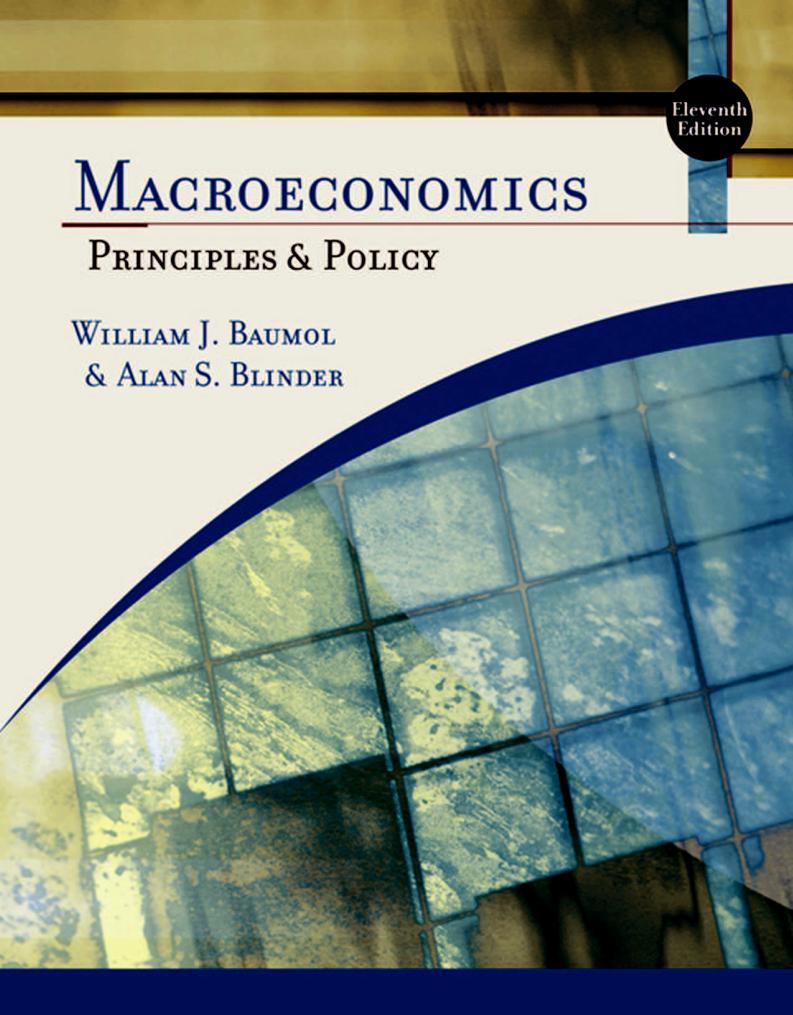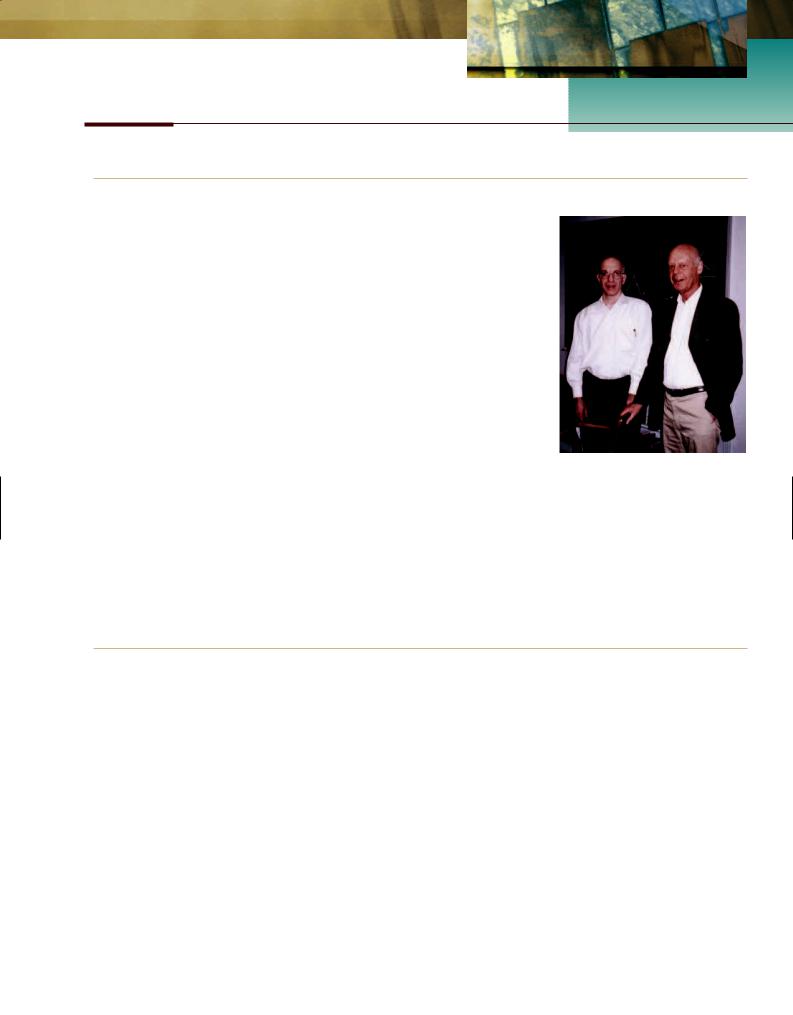
Baumol & Blinder MACROECONOMICS (11th ed)
.pdf

MACROECONOMICS
Principles and Policy
Eleventh Edition


MACROECONOMICS
Principles and Policy
Eleventh Edition
William J. Baumol
New York University and Princeton University
Alan S. Blinder
Princeton University
Australia • Brazil • Japan • Korea • Mexico • Singapore • Spain • United Kingdom • United States

Macroeconomics: Principles and Policy, 11e William J. Baumol, Alan S. Blinder
VP/Editorial Director: Jack W. Calhoun Editor-in-Chief: Alex von Rosenburg Executive Editor: Mike Worls Developmental Editor: Katie Yanos Marketing Manager: John Carey
Marketing Communications Manager: Sarah
Greber
Content Project Manager: Heather Mann
Manager, Editorial Media: John Barans
Technology Project Editor: Deepak Kumar
Senior Buyer—Manufacturing: Sandee Milewski
Production Service: Pre-PressPMG
Compositor: Pre-PressPMG
Senior Art Director: Michelle Kunkler
Cover Design: Lisa Albonetti
Internal Design: Lisa Albonetti
Cover Images: © Getty Images; © First Light Associated Photographers, Inc.
Senior Permissions Rights Acquisitions Account
Manager—Images: Deanna Ettinger
© 2009South-Western Cengage Learning
ALL RIGHTS RESERVED. No part of this work covered by the copyright herein may be reproduced, transmitted, stored or used in any form or by any means graphic, electronic, or mechanical, including but not limited to photocopying, recording, scanning, digitizing, taping, Web distribution, information networks, or information storage and retrieval systems, except as permitted under Section 107or 108of the 1976United States Copyright Act, without the prior written permission of the publisher.
For product information and technology assistance, contact us at
Cengage Learning Academic Resource Center, 1-800-423-0563
For permission to use material from this text or product, submit all requests online at www.cengage.com/permissions
Further permissions questions can be emailed to permissionrequest@cengage.com
ExamView® and ExamView Pro® are registered trademarks of FSCreations, Inc. Windows® is a registered trademark of the Microsoft Corporation used herein under license.
Library of Congress Control Number: 2007922480
Library of Congress Control Number: 2008926814 Student Edition ISBN-13: 978-0-324-58621-3 Student Edition ISBN-10: 0-324-58621-3 Instructor’s Edition ISBN-13: 978-0-324-58631-2 Instructor’s Edition ISBN-10: 0-324-58631-0
South-Western Cengage Learning
5191 Natorp Boulevard
Mason, OH 45040
USA
Cengage Learning products are represented in Canada by Nelson Education, Ltd.
For your course and learning solutions, visit academic.cengage.com
Purchase any of our products at your local college store or at our preferred online store www.ichapters.com
PRINTED IN THE UNITED STATES
1 2 3 4 5 6 7 12 11 10 09 08

ABOUT THE AUTHORS
WILLIAM J. BAUMOL
William J. Baumol was born in New York City and received his BSS at the College of the City of New York and his Ph.D. at the University of London.
He is the Harold Price Professor of Entrepreneurship and Academic Director of the Berkley Center for Entrepreneurial Studies at New York University, where he teaches a course in introductory microeconomics, and the Joseph Douglas Green, 1895, Professor of Economics Emeritus and Senior Economist at Princeton University. He is a frequent consultant to the management of major firms in a wide variety of industries in the United States and other countries as well as to a number of governmental agencies. In several fields, including the telecommunications and electric utility industries, current regulatory policy is based on his explicit recommendations. Among his many contributions to economics are research on the theory of the firm, the contestability of markets, the economics of the arts and other services—the “cost disease of the services” is often referred to as “Baumol’s disease“—and economic growth, entrepreneurship, and innovation. In addition to economics, he taught a course in wood sculpture at Princeton for about 20 years and is an accomplished painter (you may view some of his paintings at http://pages.stern.nyu.edu/~wbaumol/).
Professor Baumol has been president of the American Economic Association and three other professional societies. He is an elected member of the National Academy of Sciences, created by the U.S. Congress, and of the American Philosophical Society,
founded by Benjamin Franklin. He is also on the board of trustees of the National Council on Economic Education and of the Theater Development Fund. He is the recipient of
11 honorary degrees.
Baumol is the author of more than 35 books and hundreds of journal and newspaper articles. His writings have been translated into more than a dozen languages.
ALAN S. BLINDER
Alan S. Blinder was born in New York City and attended Princeton University, where one of his teachers was William Baumol. After earning a master’s degree at the London School of Economics and a Ph.D. at MIT, Blinder returned to Princeton, where he has taught since 1971, including teaching introductory macroeconomics since 1977. He is currently the Gordon S. Rentschler Memorial Professor of Economics and co-director of Princeton’s Center for Economic Policy Studies, which he founded.
In January 1993, Blinder went to Washington as part of President Clinton’s first Council of Economic Advisers. Then, from June 1994 through January 1996, he served as vice chairman of the Federal Reserve Board. He thus played a role in formulating both the fiscal and monetary policies of the 1990s, topics discussed extensively in this book. He has also advised several presidential campaigns.
Blinder has consulted for a number of the world’s largest financial institutions, testified dozens of times before congressional committees, and been involved in several entrepreneurial start-ups. For many years, he has written newspaper and magazine articles on economic policy, and he currently has a regular column in the New York Times Sunday Business Section. In addition, Blinder’s op-ed pieces still appear periodically in other newspapers. He also appears frequently on PBS, CNN, CNBC, and Bloomberg TV.
V

VI |
ABOUT THE AUTHORS |
Blinder has served as president of the Eastern Economic Association and vice president of the American Economic Association and is a member of the American Philosophical Society, the American Academy of Arts and Sciences, and the Council on Foreign Relations. He has two grown sons, two grandsons, and lives in Princeton with his wife, where he plays tennis as often as he can.

BRIEF CONTENTS
PART 1 |
GETTING ACQUAINTED WITH ECONOMICS |
|
|
CHAPTER 1 |
WHAT IS ECONOMICS? 3 |
|
CHAPTER 2 |
THE ECONOMY: MYTH AND REALITY 21 |
|
CHAPTER 3 |
THE FUNDAMENTAL ECONOMIC PROBLEM: SCARCITY AND CHOICE 39 |
|
CHAPTER 4 |
SUPPLY AND DEMAND: AN INITIAL LOOK 55 |
PART 2 |
THE MACROECONOMY: AGGREGATE SUPPLY AND DEMAND |
||
|
CHAPTER 5 |
AN INTRODUCTION TO MACROECONOMICS 83 |
|
|
CHAPTER 6 |
THE GOALS OF MACROECONOMIC POLICY |
105 |
|
CHAPTER 7 |
ECONOMIC GROWTH: THEORY AND POLICY |
133 |
|
CHAPTER 8 |
AGGREGATE DEMAND AND THE POWERFUL CONSUMER 153 |
|
|
CHAPTER 9 |
DEMAND-SIDE EQUILIBRIUM: UNEMPLOYMENT OR INFLATION? 175 |
|
|
CHAPTER 10 |
BRINGING IN THE SUPPLY-SIDE: UNEMPLOYMENT AND INFLATION? 199 |
|
PART 3 |
FISCAL AND MONETARY POLICY |
|
|
|
CHAPTER 11 |
MANAGING AGGREGATE DEMAND: FISCAL POLICY |
221 |
|
CHAPTER 12 |
MONEY AND THE BANKING SYSTEM 241 |
|
|
CHAPTER 13 |
MANAGING AGGREGATE DEMAND: MONETARY POLICY 261 |
|
|
CHAPTER 14 |
THE DEBATE OVER MONETARY AND FISCAL POLICY |
277 |
|
CHAPTER 15 |
BUDGET DEFICITS IN THE SHORT AND LONG RUN |
299 |
|
CHAPTER 16 |
THE TRADE-OFF BETWEEN INFLATION AND UNEMPLOYMENT 317 |
|
PART 4 |
THE UNITED STATES IN THE WORLD ECONOMY |
|
|
CHAPTER 17 |
INTERNATIONAL TRADE AND COMPARATIVE ADVANTAGE 339 |
|
CHAPTER 18 |
THE INTERNATIONAL MONETARY SYSTEM: ORDER OR DISORDER? 361 |
|
CHAPTER 19 |
EXCHANGE RATES AND THE MACROECONOMY 379 |
VII


TABLE OF CONTENTS
Preface xix
PART 1 GETTING ACQUAINTED WITH ECONOMICS 1
CHAPTER 1 WHAT IS ECONOMICS? 3
IDEAS FOR BEYOND THE FINAL EXAM 4
Idea 1: How Much Does It Really Cost? 4
Idea 2: Attempts to Repeal the Laws of Supply and Demand—The Market Strikes Back 5 Idea 3: The Surprising Principle of Comparative Advantage 5
Idea 4: Trade Is a Win-Win Situation |
5 |
|
|||||
Idea 5: Government Policies Can Limit Economic Fluctuations—But Don’t Always Succeed 6 |
|||||||
Idea 6: The Short-Run Trade-Off between Inflation and Unemployment |
6 |
||||||
Idea 7: Productivity Growth Is (Almost) Everything in the Long Run 6 |
|
||||||
Epilogue |
7 |
|
|
|
|
||
INSIDE THE ECONOMIST’S TOOL KIT |
7 |
|
|
||||
Economics as a Discipline |
7 |
|
|
|
|||
The Need for Abstraction |
7 |
|
|
|
|||
The Role of Economic Theory 9 |
|
|
|
||||
What Is an Economic Model? 10 |
|
|
|
||||
Reasons for Disagreements: Imperfect Information and Value Judgments |
11 |
||||||
Summary |
12 |
|
|
|
|
|
|
Key Terms |
12 |
|
|
|
|
|
|
Discussion Questions 12 |
|
|
|
|
|||
APPENDIX: USING GRAPHS: A REVIEW |
13 |
|
|||||
Graphs Used in Economic Analysis |
13 |
|
|||||
Two-Variable Diagrams |
13 |
|
|
|
|||
The Definition and Measurement of Slope 14 |
|
||||||
Rays Through the Origin and 45° Lines 16 |
|
||||||
Squeezing Three Dimensions into Two: Contour Maps 17 |
|
||||||
Summary |
18 |
|
|
|
|
|
|
Key Terms |
18 |
|
|
|
|
||
Test Yourself |
18 |
|
|
|
|
||
CHAPTER 2 THE ECONOMY: MYTH AND REALITY 21
THE AMERICAN ECONOMY: A THUMBNAIL SKETCH 22
A Private-Enterprise Economy |
23 |
A Relatively “Closed” Economy |
23 |
A Growing Economy . . . 24
But with Bumps along the Growth Path 24
THE INPUTS: LABOR AND CAPITAL 26
The American Workforce: Who Is in It? 27
The American Workforce: What Does It Do? 28
The American Workforce: What It Earns 29
Capital and Its Earnings 30
THE OUTPUTS: WHAT DOES AMERICA PRODUCE? 30
THE CENTRAL ROLE OF BUSINESS FIRMS 31
WHAT’S MISSING FROM THE PICTURE? GOVERNMENT 32
The Government as Referee 33
The Government as Business Regulator 33
IX
